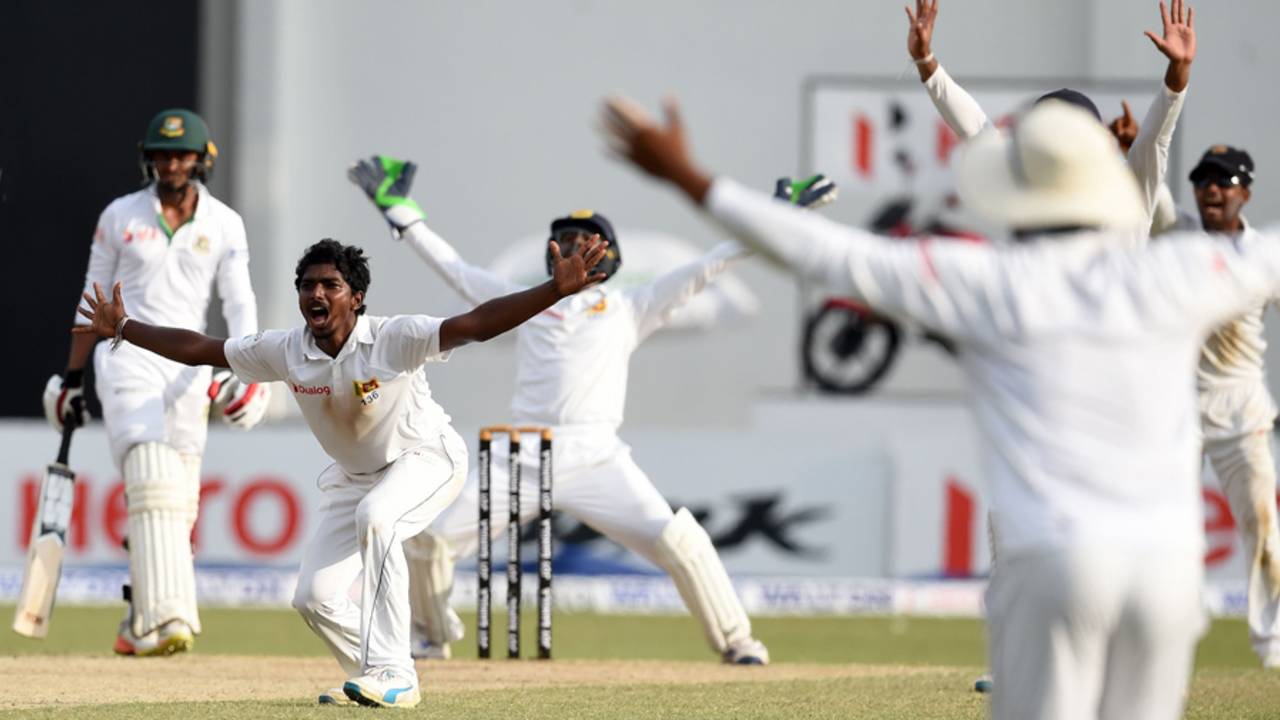When Colombo hosted a clinic in incompetence
The final hour of play on the second day was a hilarious mixture of errors that took away from an otherwise competitive match
Andrew Fidel Fernando in Colombo
16-Mar-2017
Lakshan Sandakan had to bring out his very best to claim wickets in the last half hour of play; he also had to bowl • AFP
Sunil Gavaskar whips a ball past midwicket in a second-innings 221 at the Oval in 1979, defying Ian Botham and Bob Willis like a foreign pathogen beating off white blood cells.
Muttiah Muralitharan connives his way through the great Indian top order at the SSC in 2008, claiming match figures of 11 for 110, having dismissed Sachin Tendulkar and Sourav Ganguly twice.
There are days of Test cricket that are transcendental. In them: glorious moments when the game surges, stops the heart, thrills, deceives, erupts, strikes elemental chords, and resonates with fans long after they have stopped watching. Not among them: the last hour of day two at the P Sara Oval, where ground strokes were caressed over the boundary, batsmen spooned catches tenderly into the air, an umpire abandoned belief in lbws and the laws of physics, and a fielder used the ball as a blunt instrument to hurt himself with.
It is no real surprise that it was the hosts' mistakes on the field that began to debase the tone of the contest, which had been compelling until then. Maybe in centuries to come, scholars will place this era of Sri Lankan fielding alongside Charlie Chaplin's films and Monty Python's wonder years, as one of the crowning comedic achievements of mankind.
Who could, after all, fail to be moved by such extravagant antics as Suranga Lakmal's chase around the fine-leg boundary in the 53rd over of Bangladesh's innings? He had picked up the shot early, tracked it all the way, then once in reach of the ball, dived gallantly over the top of it - all that effort just to provide the ball shelter on the final second of its journey to the boundary. It brought to mind those garden parties, where the moment a drizzle starts, men rush furiously to the aid of a pretty girl to offer coats and umbrellas.
And what of the dropped catches? Imrul Kayes hit a ball directly to Dinesh Chandimal at deep square leg, but instead of using his hands to receive it, he let it hit him just above his knee like a footballer receiving an overhead pass. The ball did fall dead at his feet, so at least it was a good first touch. Upul Tharanga was also at deep square leg, when in the penultimate over he raised both hands and pushed at the ball, like a volleyball player trying to set the ball up for a team-mate. Unfortunately the ball boys at the boundary missed the opportunity to jump up from behind him and spike it down the line. In between these two drops, Dhananjaya de Silva dived on the ball and hurt his thigh.

Suranga Lakmal played both hero and victim in the comedy•NurPhoto/Getty Images
It is possible, though, that as well-rehearsed as Sri Lanka's japery seemed, they were outshone by Bangladesh's slapstick batting. Imrul had hacked that ball to deep square leg at 25 when an important overnight not-out beckoned. Sabbir Rahman literally watched Sri Lanka install a leg slip because he seemed keen on the pull shot, and soon after sent a catch to that very fielder, the ball hanging gently in the air like low-hanging fruit waiting to be plucked. Shakib Al Hasan was then the guy dropped by Tharanga in the penultimate over - also pulling, all on a pitch that had now become good to bat on. Where Bangladesh's middle order should have been the rescue ships that bailed the top order out, they all sailed gaily into the same piece of rock in the wide open sea, and could have so very nearly all drowned. Even their backroom staff were left stunned.
"The last half hour and the first half hour are generally the most dangerous periods of a day, and it was with one shot that we lost three wickets," Bangladesh's batting coach Thilan Samaraweera said. "We've got to stop that. When you're playing Tests as a batsman, you need to be aware of what the other team is doing. In a Test sometimes you get periods of 30-36 balls that are very difficult. That's what you've got to endure, because it does get easy to score runs after that."
While both teams only put on their clinic in incompetence in the last hour of play, S Ravi had been getting decisions wrong all through the match, failing to give lbws that were almost plumb, and raising the finger to balls clearly headed down the leg side. He got so many wrong, fielders' appealing eventually started to feel unnecessarily cruel. Taijul Islam was given not out off Lakshan Sandakan in the final passage of play, but having missed the opportunity to reverse earlier decisions, Sri Lanka finally managed to overturn one.
Sessions such as these won't inspire poems. No biographies may mention them, and few fans will relive these overs in their minds, in years to come. But that doesn't mean there is no value here.
Gavaskar and Murali are wonderful, but simultaneous self-sabotage from rival players is also not without its charms.
Andrew Fidel Fernando is ESPNcricinfo's Sri Lanka correspondent. @andrewffernando
